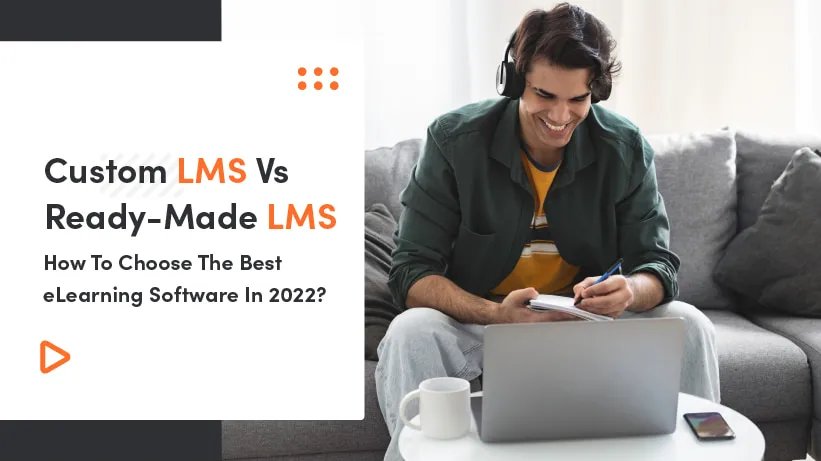Technology has significantly transformed the way teaching and learning occur outside traditional classroom settings. In 2019, the global eLearning market was worth around $101 billion while the learning management system market generated $18 billion. By 2026, the total eLearning market is forecasted to reach over $370 billion. eLearning increased learning retention rates by 25%-60% and it takes approximately 40% to 60% less time to complete a corporate eLearning compared to traditional learning.
Nearly 98% of companies declared to incorporate online learning into their corporate education.
Is your business one of them? Are you looking for the right solution? TThis article explores the distinctions between the custom built software and ready-made Learning Management Systems (LMS), offering guidance on choosing the most suitable option based on your specific business needs.
What will you learn from this article?
- Differences between custom-built software and ready-made,
- Advantages and disadvantages of opting for a ready-made LMS,
- What benefits can companies expect when combining elements of both custom software and ready-made LMS,
- How to maximise the effectiveness of their chosen LMS, whether it's custom or ready-made?
EXPERT INSIGHT: Why LMS Matters
Learning Management Systems play a crucial role in modern education and corporate training. With the global eLearning market expected to reach over $370 billion by 2026, understanding the nuances of LMS options is essential for effective educational strategies and business growth.
If you're interested in the most popular LMSs or want to know when to choose a custom one, click here: Top 10 Best LMS Platforms in 2025 (Compared + When to Go Custom)
What is LMS Software?
LMS is an online learning management system that can be used to create digital classrooms or to train employees. LMS offers features like skill tracking, course and content management, analytics with detailed statistics and gamification. Those systems can also be equipped with notifications, live chats to connect learners with instructors or allow test creation and file sharing. What is more, by choosing a custom-made solution companies are able to adjust the software according to their requirements and its main purpose. However, not everybody wants to build their own LMS as there is a lot of ready-made software available, which obviously has its pros and cons.
Pros and cons of ready-made LMS
Pros:
- less expensive than building your own solution
- no need to worry about updates, improvements etc
- battle-tested by other users
- faster implementation
- some LMS are tailor-made for specific industries
Cons:
- no customization
- may lack some features while you need to pay for those you will not use
- adding new users may increase the costs
- you have to adapt to any changes
When to choose a ready-made LMS?
A ready-made LMS is a great option for companies with a smaller budget and less specific needs. It is also a perfect choice for those on a time crunch as an out-of-a-box, custom
Practical Advice - Choosing the Right LMS software solutions.
Try our developers.
Free for 2 weeks.
No risk. Just results. Get a feel for our process, speed, and quality — work with our developers for a trial sprint and see why global companies choose Selleo.
What is a Custom LMS?

When choosing the best LMS apart from ready-made solutions we can also distinguish so-called custom LMS. Custom Learning Management Systems means users buy the software and install it on their server. Such a solution gives you the power to develop and deploy online training to address the specific issues of your company.
Custom LMS allows full customization as far as the look or feel of the LMS goes, as well as extra capabilities, integrations and functionalities.
Pros and cons of a custom LMS
Pros:
- fully customizable
- you have control over upgrades and updates
- no need to rely on external providers
- you only pay for what you need
- no compromises necessary
Cons:
- a more financial commitment
- it may be necessary to train or hire new people
- you need to improve and manage it
- you are responsible for fixing problems
Practical Advice - Choosing the Right LMS software solutions
Decision-Making Framework
Selecting the right Learning Management System (LMS) for your organisation involves careful consideration of several key factors. Here’s a structured step-by-step guide to help you make an informed decision:
- 1. Identify Your Needs: Begin by defining the specific goals and objectives of your LMS. Are you aiming to improve employee training, support customer education, or provide online academic courses?
- 2. Budget Consideration: Determine your budget for the LMS. Include not only the initial costs but also ongoing expenses such as maintenance, updates, and customer support.
- 3. Scalability: Assess the scalability of the LMS. Can it grow and adapt as your organisational needs evolve? Consider the ease of adding new users, courses, and functionality.
- 4. Ease of Integration: Evaluate how well the LMS integrates with your existing systems (e.g., HR software, customer relationship management systems, and other educational tools).
- 5. User Experience: Focus on the user interface and user experience. The LMS should be intuitive and easy to navigate for both administrators and learners.
- 6. Support and Customer Service: Consider the level of support provided. Reliable customer service is crucial for addressing technical issues and user training.
- 7. Trial and Evaluation: If possible, utilise a trial period to test the LMS in real-world scenarios to ensure it meets your expectations and is compatible with your technical infrastructure.
Features to Consider
When evaluating different LMS options, it’s important to focus on certain key features that can significantly impact the effectiveness and usability of the system. Here is a breakdown of essential functionalities to consider:
- Content Management: Ability to create, manage, and distribute educational content easily. Look for features like drag-and-drop content builders and rich text formatting.
- Assessment Tools: Tools for creating and managing quizzes, tests, and assignments to evaluate learner progress.
- Customisation Options: The extent to which the LMS can be customised to reflect your organisation's brand and educational approach.
- Analytics and Reporting: Comprehensive analytics tools that provide insights into learner engagement, progress, and completion rates.
- Mobile Compatibility: Ensure the LMS is optimised for mobile use, allowing users to access content and learning tools from any device.
- Social Learning Features: Tools that support social learning, such as discussion forums, peer feedback, and group collaborations.
- Security Features: Robust security measures to protect sensitive data, including encryption, secure authentication methods, and data compliance features.
- Accessibility: Compliance with accessibility standards to ensure all learners, regardless of disability, can effectively use the LMS.
By focusing on these features, you can select an LMS that not only meets your functional requirements but also enhances the learning experience, making it engaging and accessible for all users
Which Learning Management Solution is Right For Your Needs?
There is no universal answer to that question as it will depend on variables, for example, time frame, budget and IT capabilities. However, a ready-made LMS is still the most frequently chosen software, in comparison to its custom counterparts.
14 Benefits of Hybrid Product
In Selleo, we believe it is possible to connect parts of the off-shelf LMS and custom software and we have created many platforms like that. Having such a hybrid product will give you benefits like:
- 1. Cost-effectiveness - You get an application with pre-defined base features like course creation, authentication, roles or gradients.
- 2. Customization - First, you will get a working product with base components, which can be later expanded to better suit your needs.
- 3. Hosting - As your development team, we will handle hosting and deploying your application. The back-end developers will take care of performance issues, reliability and security.
- 4. Improved functionality - Skilled developers will choose specific elements and features to be added to your system in order to make it intuitive and user-friendly.
- 5. Branding - The application can be customized with brand colours, logo at the very beginning to increase aesthetics and gain credibility. Good branding is crucial for brand recognition. You can read more about it on our blog How To Build A Branding For Your Mobile App.

- 6.Fast implementation - A SaaS LMS combined with a custom LMS is super fast to implement since it is pre-built. within a few weeks, you will have a fully functional eLearning solution that you can use to train employees.
- 7. Less time-consuming - Our developers will decrease the waiting time by quickly implementing new functionalities or adjusting the existing ones.
- 8. Up-to-date - It is important to stay fresh and up-to-date. That is why, your application should be frequently updated with new styles, features etc.
- 9. Scalability - You are able to upscale or downscale your existing system when necessary and our backend developers will help you do so.
- 10. Addressing issues - If an issue occurs, our development team is always prepared to solve it.
- 11. Front-end support - Our front-end developers are able to add new functionalities, modify styles and fix bugs within your product. They are experts in what they do. By working with us you
get access to high quality and effective solutions. Our developers are innovative and use the latest technologies.
- 12. Back-end development - The backend engineers will help you with hostings, APIs, SSLs and will handle the security matters for you.
- 13. Graphic team - A fully-fledged graphic team will handle the design as well as UX/UI. They are handling this process in 6 easy steps. The most important aspect of the collaboration is mutual understanding combined with extensive market research. Our graphic team creates mockups in order to help you understand the vision, which is later turned into a working application.

- 14. QA - The QA team will cover functionality tests to increase the usability, reliability and availability of the app. Quality Assurance is an important process that determines whether the service follows a set of requirements. It aims to improve work processes and efficiency while boosting credibility and customer confidence. QA identifies potential flaws and maximizes the quality of the product. At Selleo, we are convinced that QA is a crucial part of any successful project.
If you want to get more information about Quality Assurance, read our post Why Is a Quality Assurance Tester Needed On a Software Development Team?
A custom-made learning management system will be optimized for your needs in order to create an online training platform perfect for you. Everything can be changed and adapted at any time.
Integration and Customisation Tips
To maximise the effectiveness of your Learning Management System (LMS), whether it's a ready-made or a custom solution, consider these strategies for enhancement:
- Integration with Existing Tools: Ensure your LMS seamlessly integrates with existing tools and systems such as HR platforms, CRM software, and collaboration tools. This integration can automate workflows, like syncing employee data or tracking customer interactions for training purposes.
- Custom User Interfaces: Tailor the look and feel of your LMS to match your organization's branding. This includes custom logos, colour schemes, and layout adjustments to provide a consistent user experience that aligns with other corporate tools.
- Feature Extensions: Enhance a ready-made LMS by adding specific features that address unique business needs. This might include advanced reporting capabilities, bespoke assessment modules, or specialized content libraries.
- API Utilization: Make use of APIs to build custom integrations and functionalities. This can help you create a more flexible and powerful learning environment that adapts to dynamic educational needs.
- User Feedback Incorporation: Regularly collect and analyse user feedback to identify areas for improvement. Use this data to make informed decisions about custom features that enhance user satisfaction and engagement.
Ongoing Customisation: Treat your LMS as a dynamic tool. Continuously refine and adapt the system as your organizational needs evolve and new training technologies emerge.
Expert Tips for Smooth Implementation
Implementing a new LMS can be a complex process. Here are expert insights to ensure a successful rollout:
- Comprehensive Planning: Start with a detailed plan that includes clear objectives, a timeline, resource allocation, and risk management strategies. Ensure all stakeholders are on board and understand their roles in the process.
- Stakeholder Engagement: Engage with all key stakeholders early in the process. Include representatives from various departments to ensure the LMS meets cross-functional needs and gains wide acceptance.
- Pilot Testing: Before full-scale implementation, conduct a pilot test with a select group of users. This test can help identify any technical issues or user concerns that need addressing.
- Training and Support: Provide comprehensive training for all users, including administrators, instructors, and learners. Make sure ongoing support is available to address any questions or issues post-implementation.
- Data Migration: If transitioning from an old system, ensure a smooth migration of data. This involves careful planning to secure data integrity and minimal disruption to existing learning processes.
- Change Management: Manage resistance to change by clearly communicating the benefits of the new LMS and how it will improve learning outcomes and operational efficiency.
- Feedback Loop: Establish a feedback loop to continually gather insights from users about the LMS’s functionality and user experience. Use this feedback for ongoing improvements.
By following these tips, you can enhance your LMS to better serve your educational needs and ensure its successful implementation within your organization.
Summary
Choosing the right solution is not an easy task and there are a lot of things that have to be taken into consideration. Like I mentioned above, time and budget will play the biggest role. We believe a custom LMS solution combined with some custom capabilities will not only be cost-effective and scalable but also fast to implement, constantly up-to-date and best suited for your business requirements.





